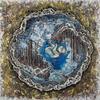Gerald E. Buck Endows the Archives of American Art’s West Coast Collecting Program with $2.5M Gift
- WASHINGTON, DC
- /
- October 23, 2017
The Smithsonian’s Archives of American Art (the Archives) announced today that it has received a generous bequest of $2.5 million from Gerald E. Buck (1940‒2013) through The Buck Family Trust, based in Orange County, CA to endow the Archives’ collecting program on the West Coast.
A longtime member of the Archives’ Board of Trustees and an avid collector of California art, Gerald Buck was deeply committed to the Archives’ mission to collect, preserve, and make available primary sources documenting the history of art in the U.S., and specifically in California. The bequest ensures that collections including original letters, diaries and other unpublished writings, photographs, rare printed materials, and financial records illuminating the history of art in California will be preserved for future generations and made available at the Archives’ offices in Washington, DC, and internationally via its website.
Between 1973 and 2005, under the leadership of Dr. Paul J. Karlstrom, the Archives had offices on the West Coast, first at the M. H. de Young Memorial Museum in San Francisco (1973‒91), and then the Virginia Steele Scott building at the Huntington Library, Art Galleries, and Botanical Gardens in San Marino (1984‒2005). The Archives and its host institutions enjoyed strong synergetic relationships, each contributing to the other’s effectiveness as eminent research and collecting organizations.
Since 2005, the Archives has continued to collect in California independent of a host institution. Dr. Susan Erhlich served as the Archives’ West Coast representative (2003‒06) followed by Hunter Drohojowska-Philp (2012‒15). In October 2016, Dr. Matthew Simms was named the Archives’ Gerald and Bente Buck West Coast Collector. Dr. Simms is Professor of Art History at California State University, Long Beach, where he teaches European and American modern art and criticism.
Through its ongoing collecting efforts, the Archives established valuable networks on the West Coast and acquired significant collections of primary sources. Among them are the personal papers of Robert Alexander and the Temple of Man, Carlos Almaraz, Billy Al Bengston, Wallace Berman, Elmer Bischoff, Imogen Cunningham, Roy De Forest, Jay DeFeo, Eleanor Dickinson, Lorser Feitelson, Ralph Goings, Elyse and Stanley Grinstein, Frederick Hammersley, David Ireland, Craig Kauffman, Philip Leider, Jacob Lawrence, Helen Ludwig, Jim Melchert, Emmy Lou Packard, David Park, Agnes Pelton, Peter Plagens, Stanton Macdonald-Wright, Esther McCoy, Ed Mieczkowski, Mel Ramos, Peter Selz, Hassel Smith, Beatrice Wood, and Charles White, and the records of the Candy Store Gallery, Delexi Gallery, Frank Perls Gallery, Nicholas Wilder Gallery, Richard Kuhlenschmidt Gallery, Rosamund Felsen Gallery, and the Woman’s Building, among others.
The Archives’ Oral History Program also thrived, resulting in the assembly and preservation of the largest and most significant collection of audio-recorded interviews with West Coast art luminaries such as John Baldessari, Richard Diebenkorn, David Hockney, and Ed Ruscha. Ruscha’s taping, for example, ran ten hours over four sessions. Other extensive interviews include Lita Albuquerque, Peter Alexander, Terry Allen, Viola Frey, Carmen Lomas Garza, Sam Maloof, Bruce Nauman, Nathan Oliveira, John Valadez, Susan Rothenburg, Fritz Scholder, Wayne Thiebaud, William T. Wiley, and Bill Viola, among many others.
“A life-long learner and champion of California artists, Gerald Buck’s thirst for knowledge drew him to the Archives of American Art. He had a deep appreciation of the Archives’ on-the-ground commitment to document California art. As a Trustee from 1994 until his death in 2013, his steadfast and enlightened support help us develop unparalleled resources and promote new scholarship,” said Kate Haw, director of the Archives of American Art. “This generous gift is Gerald’s lasting legacy to the art world he loved and a collecting program he passionately supported and now sustains.”
About the Archives of American Art
Founded in 1954, the Archives of American Art fosters advanced research through the accumulation and dissemination of primary sources, unequaled in historical depth and breadth, that document more than 200 years of the nation’s artists and art communities. The Archives provides access to these materials through its exhibitions and publications, including the Archives of American Art Journal, the longest-running scholarly journal in the field of American art. An international leader in the digitizing of archival collections, the Archives also makes more than 2.5 million digital images freely available online. The oral history collection includes more than 2,300 audio interviews, the largest accumulation of in-depth, first-person accounts of the American art world. https://www.aaa.si.edu/
# # #


![Arthur Pinajian [1914-1999] Untitled, No.4386, 1958 Arthur Pinajian [1914-1999] Untitled, No.4386, 1958](/images/c/b7/f0/Mar14_Arthur_Pinajian_1914-1999__Untitled_No_100x100_c.jpg)













